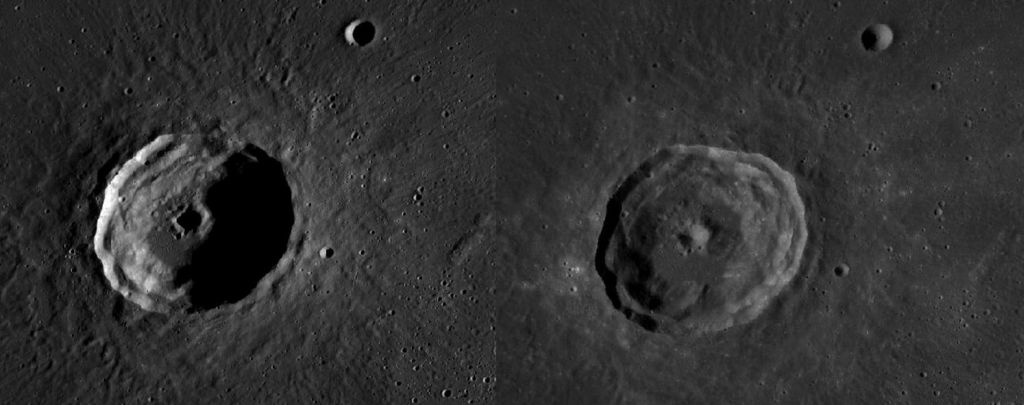Timocharis
Contents
Timocharis
|
Lat: 26.7°N, Long: 13.1°W, Diam: 33 km, Depth: 3 km, Rükl: 21, Eratosthenian |

Timocharis in the morning light shows central crater that evaporated central mountain! It looks like "Black Saturn"! On the right the evening in region is started.
Images
LPOD Photo Gallery Lunar Orbiter Images Apollo Images
- AS15-M-0600, 0599, 0598, and 0597 (four Mapping photographs of Timocharis, at the end of Revolution 22) are included in the book Full Moon by Michael Light and Andrew Chaikin (plates 37, 38, 39, and 40). Research: - DannyCaes Nov 27, 2007
Maps
(LAC zone 40B3) LAC map Geologic map LTO map IAU Nomenclature Map (PDF)
Description
Description: Elger
(IAU Directions) TIMOCHARIS.--A fine ring-plain, 23 miles in diameter (the centre of a minor ray-system). It stands isolated on the Mare Imbrium (below the level of which it is depressed some 3,000 feet), about midway between Archimedes and Lambert. Its walls, rising about 7,000 feet above the floor, are conspicuously terraced, and on their E. outer slopes exhibit some remarkable depressions. There is a distinct break on the N., and a bright little crater on the N.E., connected with the foot of the glacis by a prominent ridge. On the bright central mountain, Schmidt, in 1842, detected a crater, which is easily seen under a moderately high light. Timocharis and the neighbourhood, especially the peculiar shape of the terminator on the W. of the formation, is well worth examination at sunrise.
Description: Wikipedia
Additional Information
- Depth data from Kurt Fisher database
- Pike, 1976: 3 km
- Westfall, 2000: 3 km
- Viscardy, 1985: 3.11 km
- Cherrington, 1969: 2.86 km
- Timocharis C, D? and H are thermal anomaly craters, implying youthful ages - Moore et al, 1980
- An elongated (and north-south oriented) depression at 24°30' North/ 18° West (east-southeast of Lambert and immediately west of craterlet Timocharis E) is mentioned in APOLLO OVER THE MOON: A VIEW FROM ORBIT, Chapter 7: Unusual Features (part 1), Figure 225. Note: this is an interesting target for lunar observers with powerful telescopes. Research: - DannyCaes Nov 27, 2007
- Included on ALPO list of bright ray craters
- Included on ALPO list of banded craters
- TSI = 30, CPI = 20, FI = 20; MI =70 Smith and Sanchez, 1973
- David Barcroft (1897-1974) seems to have observed Timocharis "filled with vapor and very indistinct near Full Moon" (source: Epic Moon, page 309).
- V.A. Firsoff observed a red glow in Timocharis on the 8th and 10th of October 1954 (source: The Old Moon and the New, V.A. Firsoff, page 184), and a blue brightening on the 3rd of August 1955, as observed through a blue filter (page 185).
Nomenclature
- Named for Timocharis of Alexandria (ca. 320 BC - 260 BC), a Greek astronomer and philosopher. Likely born in Alexandria, he was a contemporary of Euclid. In approximately 3rd century BC, with the help of Aristillus, he created the first star catalogue in the Western world.
- An Internet search for a copy of that catalog leads to repeated statements that theirs (Timocharis and Aristillus') was the first, but no links to modern scholars who study Timocharis or his catalog or other works. His name is linked tightly to Hipparchos, however, because 169 years after Timocharis, Hipparchos compared his own star catalogue to Timocharis' and discovered that the longitude of the stars had changed by 2 degrees, which led him to determine the first value of the precession of the equinoxes.
- Timocharis B, the small bowl-shaped crater northeast of Timocharis, was called "Kovalevskij" on LTO-40B3 (prepared in April, 1974), for which it served as the title. Oddly, it is recorded as "a new name approved by the IAU", yet it appears not to have been approved. Kovalevskij is a variant spelling of Kovalevskaya, a name that had previously been approved (in 1970) by the IAU for an unrelated farside crater, and published in Menzel, 1971. How it came to be listed on the LTO as "approved" for the present nearside crater is unclear. It is included in Ewen Whitaker's list of Invalid Names.
LPOD Articles
Ringed with Almost Nothing Visible
Bibliography
APOLLO OVER THE MOON; A VIEW FROM ORBIT, Chapter 5: Craters (Part 4), Figure 142 (Timocharis close-up).